Fiji
yqgk302EGjo
yqgk302EGjo
Create successful ePaper yourself
Turn your PDF publications into a flip-book with our unique Google optimized e-Paper software.
FIJI Post-Disaster Needs Assessment<br />
Sugar Cane: Production losses in the sugar cane subsector are approximately F$53.6 million, which represent 12 percent<br />
of total sector losses. Most of the losses were sustained in the form of uprooted crops (mainly in the Western Division),<br />
higher input costs and lower output prices. The production loss of crops is expected to result in lower sugar production,<br />
which will negatively affect revenue and foreign exchange earnings for the current calendar year.<br />
Livestock: Estimated losses to the livestock subsector were F$5.1 million, which represents around 1 percent of total<br />
losses to the sector. These include production losses due to the death of animals and decline in meat, honey and milk<br />
production. Substantial quantities of fresh milk were lost due to power failures at milk chilling centres, and road blockages<br />
by wind-blown debris that prevented milk trucks from collecting milk from these centres. Most of the livestock losses were<br />
sustained in the Western Division (61 percent) followed by the Central Division (26 percent), Northern Division (7 percent)<br />
and Eastern Division (6 percent).<br />
Fisheries: The fisheries subsector sustained a high value of production losses, at over F$165.9 million. This was the result<br />
of extensive damage to fisheries assets and the long-term losses of production capacity of coral reef ecosystems and other<br />
fish habitats, which will significantly and durably affect rural marine-based livelihoods. A substantial part of the losses is<br />
attributed to subsistence fishing valued at F$119.7 million (72.1 percent) followed by commercial artisanal fisheries valued<br />
at F$43.6 million (26.3 percent) and semi-commercial fisheries worth $2.6 million (1.6 percent). It will take an estimated<br />
12 years for subsistence and commercial fisheries to get back to their pre-disaster production levels, provided that sound<br />
resource management is applied and no other major natural disaster occurs in the meantime. The aquaculture sector<br />
should only take a year or two to be rehabilitated, provided that the necessary resources are identified and deployed to<br />
the affected areas.<br />
Forestry: Estimated production losses to the forestry subsector totaled F$28.2 million. Native forests accounted for a<br />
substantial portion of total losses (70 percent), while plantation forests (exotic species) accounted for the remaining 30<br />
percent. The Western Division sustained the most losses (62 percent), followed by the Northern Division (28 percent),<br />
Central Division (7 percent) and Eastern Division (3 percent). Considerable production losses were recorded with Raintree<br />
in Ra, Dakua in Ba and Kaudamu in Bua.<br />
Table 22: Damage and Losses to Agriculture by Subsector (F$ million)<br />
Subsector Damage Losses Total Effects Private (%) Public (%)<br />
Crops 8.5 207.9 216.4 99 1<br />
Sugar Cane 21.8 53.6 75.4 70 30<br />
Livestock 9.2 5.1 14.3 98 2<br />
Fisheries 40.7 165.9 206.6 98 2<br />
Forestry 1.1 28.2 29.3 70 30<br />
Sector Total 81.3 460.7 542.0 93 7<br />
Source: Estimations by Assessment Team.<br />
Table 23: Damage and Losses to Agriculture by Division (F$ million)<br />
Division Damage Losses Total Effects Private (%) Public (%)<br />
Central 12.2 83.8 96.0 98 2<br />
Eastern 7.9 37.2 45.1 91 9<br />
Northern 17.4 189.2 206.6 96 4<br />
Western 43.8 150.5 194.3 88 12<br />
Sector Total 81.3 460.7 542.0 93 7<br />
Source: Estimations by Assessment Team.<br />
Social Impact of Damage and Losses to the Crops, Livestock, Sugar Cane, Fisheries and Forestry Subsectors<br />
The extensive destruction of food crops has seriously affected household income, food security and nutrition, with<br />
vegetables and root crop prices having increased significantly since the cyclone. An illustrative case is cassava, a staple<br />
food for <strong>Fiji</strong>ans, for which prices doubled from F$5 a heap before the cyclone to F$10 after the cyclone. The loss of<br />
vegetables and fruits, compounded by a considerable increase in vegetable prices, could place a stress on food budgets<br />
for most low-income earning households around <strong>Fiji</strong>, and make it worse off for those living in areas badly affected by the<br />
cyclone. There are also concerns that women, particularly pregnant and lactating women living in rural areas, may not get<br />
sufficient access to adequate nutritious food. Production losses are expected to last several years, the time required for fruit<br />
50 Tropical Cyclone Winston, February 20, 2016



